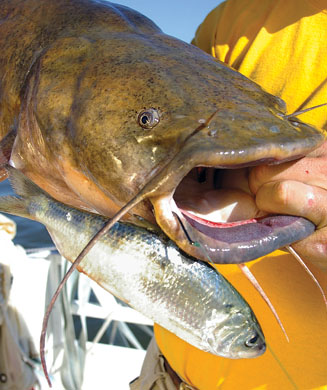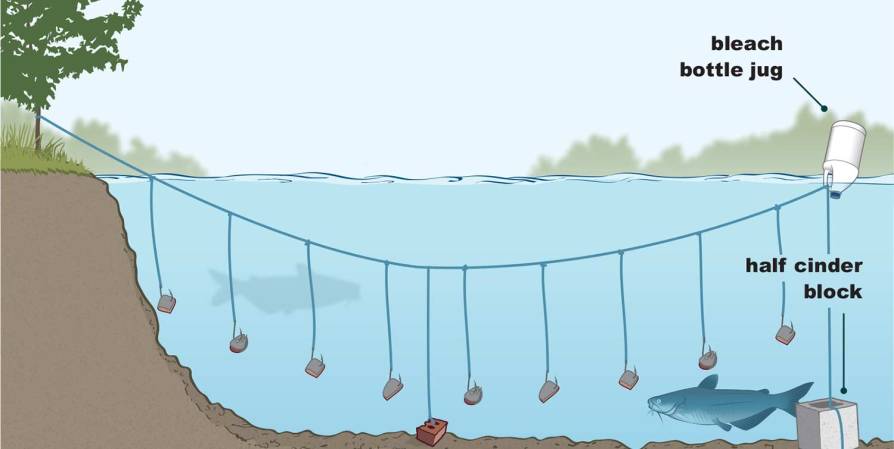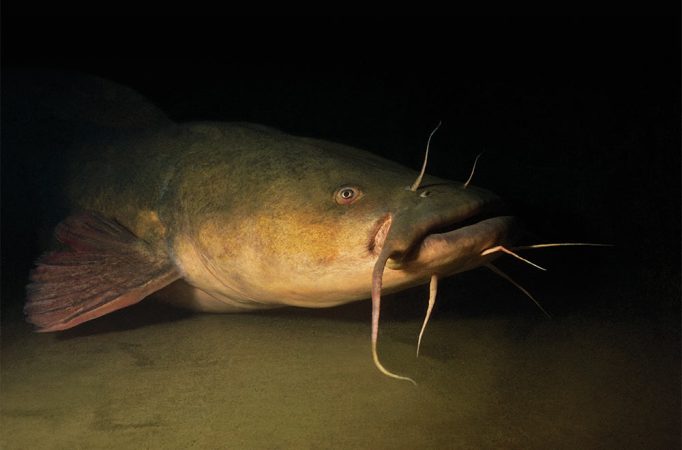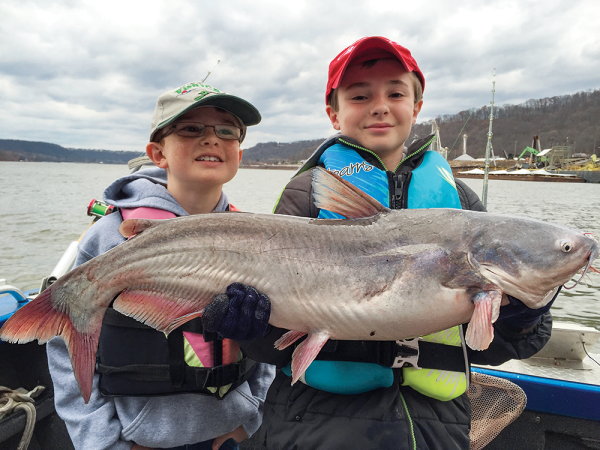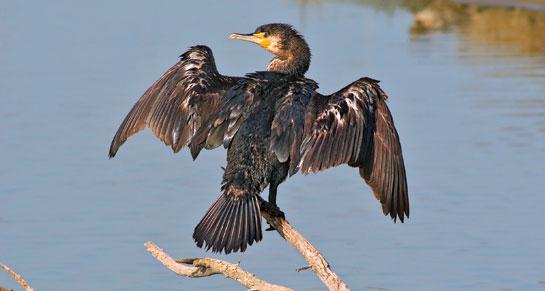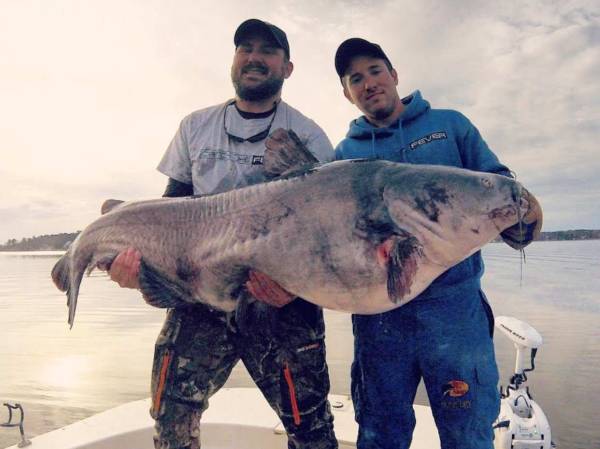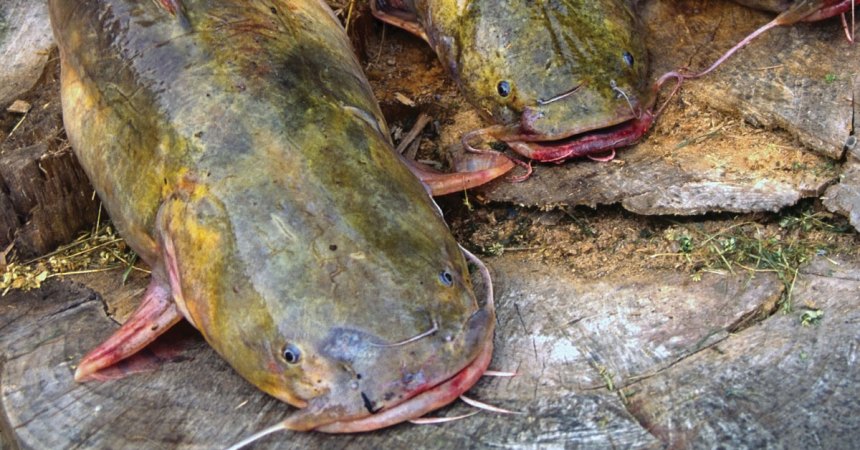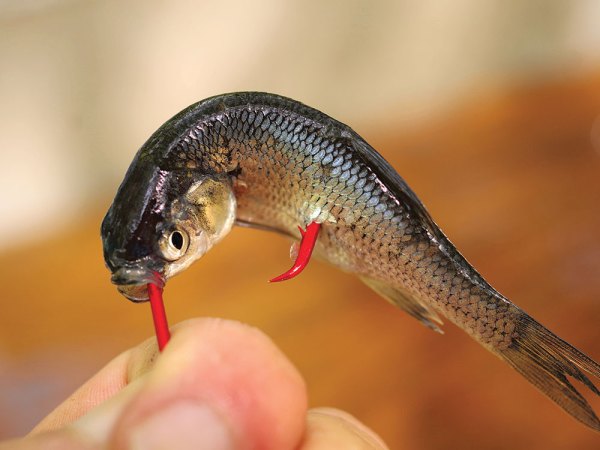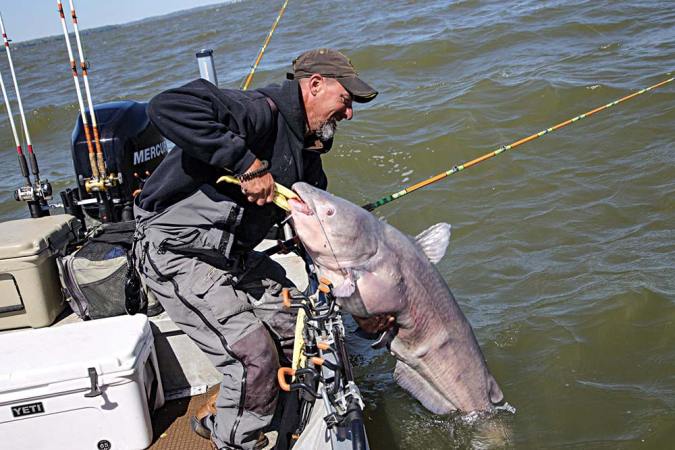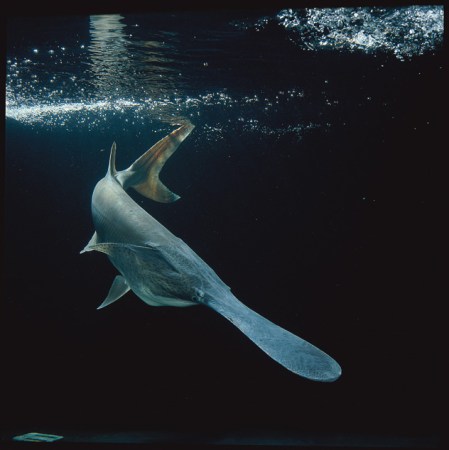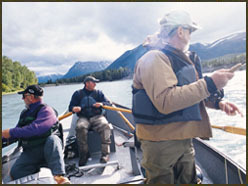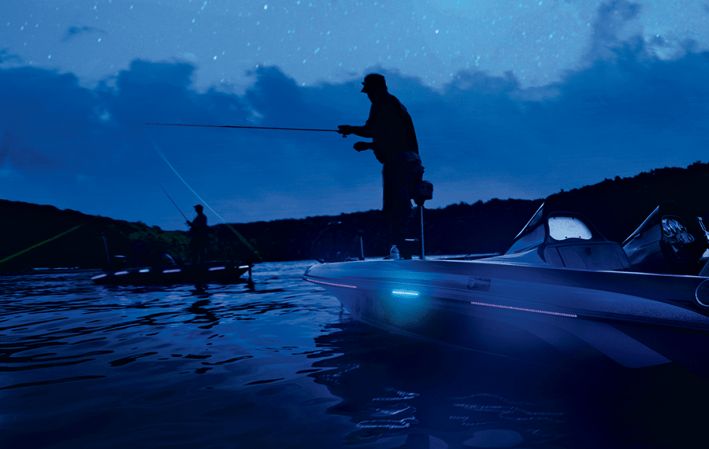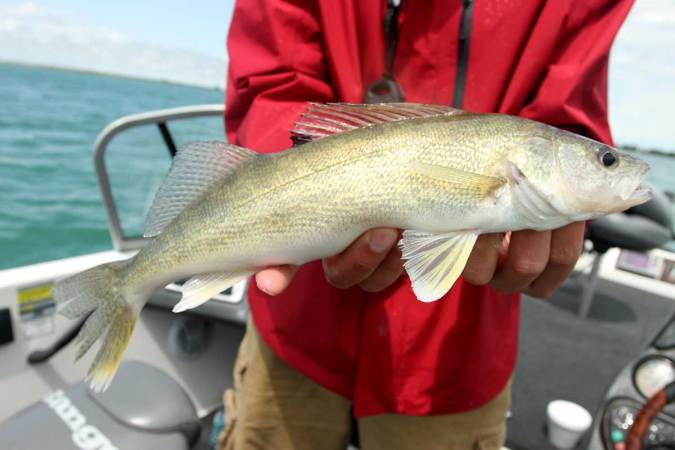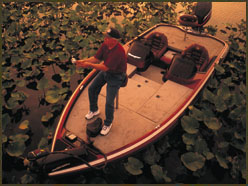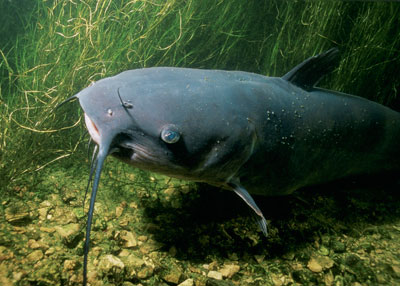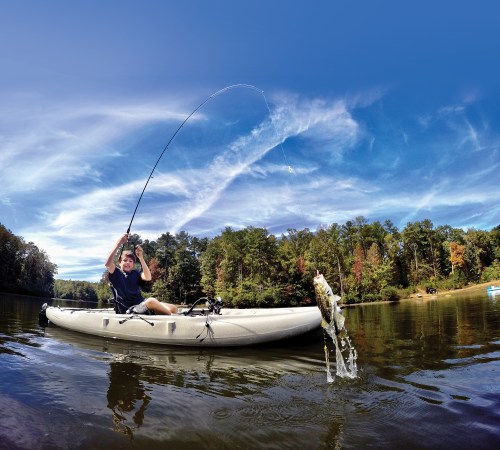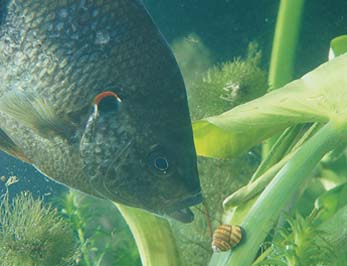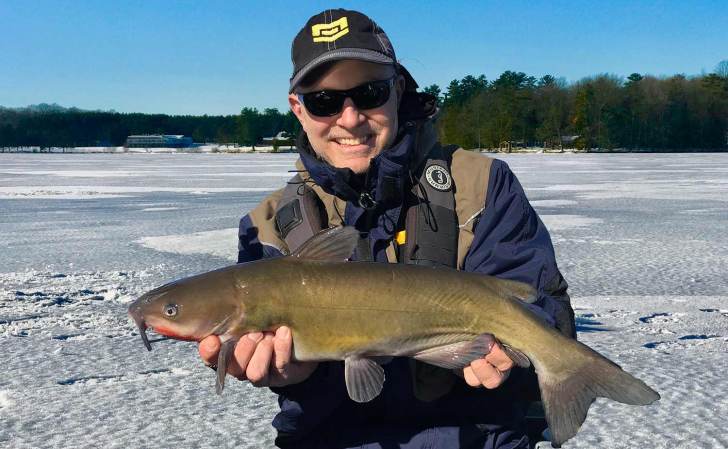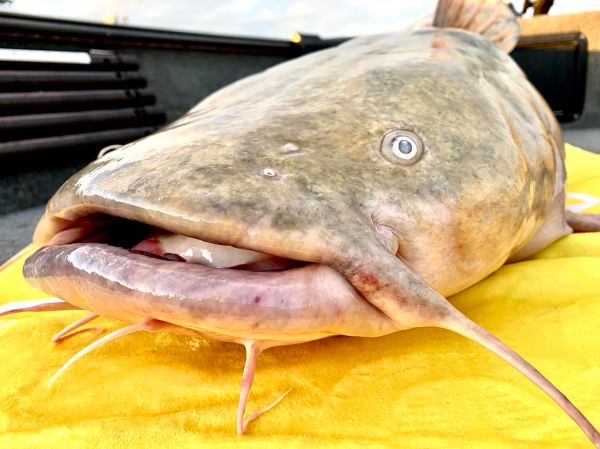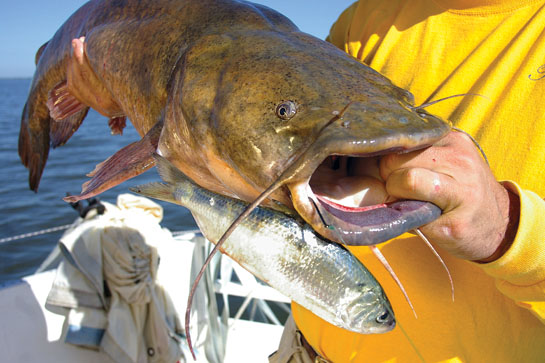
I can still recall the precise moment I became one of the afflicted. My fishing rod was doubled over, and a massive blue catfish broke the water’s surface. I brought the landing net into position and, as if it were happening in slow motion, the line snapped and the fish was gone.
Since then, I’ve learned that it’s the little things—from your bait to the knots on your terminal tackle—that add up to big results with trophy fish, and I’ve spent years learning everything I could about how to catch catfish. I’ve sought out advice from old-timers in bait shops, feed stores, and diners. I’ve drunk a lot of bad coffee and endured countless lectures about how I’ve been doing things all wrong. I eventually made friends with some like-minded anglers, collaborating with them and exchanging information. Now, every time a trophy surfaces, it brings back the memory of that first big fish. My passion for catching the biggest catfish on the planet remains.
Beating the Blues
For most catfishermen, blues are king. They grow to absurd sizes (the current world record is 143 pounds), and when the bite is on, even the smallest lakes and reservoirs can produce impressive numbers of trophy blue cats, with fish from 1 to 10 pounds quite common.
These are opportunistic predators, feeding on a wide variety of fish, mussels, and crayfish. Experts at slurping up an easy meal, blues are often found in the open water of reservoirs near striped or white bass. Locate schooling stripers or whites and you’re likely to find blues cleaning up the injured and dead baitfish below them.
Bait Selection
Some type of native fish, either cut or dead and fished whole, is true trophy blue catfish bait—no home-brewed stinky concoctions or secret sauce involved. There are countless tales that involve the effective use of grocery-store baits such as chicken livers or beef hearts that might tempt you, but trophy hunters avoid them. Nothing works consistently better than fresh shad or skipjack.
Battle Gear
The size of big blues (and flatheads, too) requires planning and thought when you select gear. The specific rule is simple: Go big and heavy, and be ready.
A monster catfish that wants to stay on the bottom is a powerful fish that is in control. The only way for an angler to win the fight is by pulling the fish off the bottom with careful and deliberate force. Long e-glass and composite rods are preferred because, unlike stiff graphite rods, they flex and bend without breaking. My top choice is an 8-foot 6-incher.
Popular among anglers, Shakespeare Ugly Stiks are available in a variety of models that are up to the task, but smaller boutique brands such as Team Catfish have cult followings among serious trophy hunters.
Round conventional reels with large line capacities, heavy cranking power, and a good drag system are essential. The Abu Garcia Ambassadeur 6500C3 round reel is the undisputed king of catfish reels. It’s a no-frills workhorse that is more than capable of doing the job.
Catfish can see well but won’t shy away from fishing line, so it’s best to spool your reel with 20- to 30-pound-test monofilament. Brightly colored yellow or green high-visibility line is easy to see and helps when monitoring for bites. Big catfish often react in very subtle ways that can only be detected through the fishing line.
Circle hooks are second to none but must be suited specifically to big catfish. A wide gap is essential, as is a heavy-gauge wire that won’t twist or bend. The 7/0 Daiichi Circle Chunk Light and the 10/0 Team Catfish Double Action Circle are tried-and-true hooks for monster catfish.
Rigging
Although there are many blue-cat rigging options, the Santee rig is popular for good reason—it’s simple yet effective. The basic rig features a sliding sinker, a 2-inch, slotted foam peg float, and a 24- to 36-inch leader. The foam float lifts the bait off the bottom, moving it out of mud or vegetation and into the line of sight of big catfish. It also helps your bait mimic their daily diet of dead or dying baitfish that flutter through the water.
Fish Finding
Blue catfish are feeding machines. Massive schools of baitfish will tip you off to the best fishing locations and are easy to spot on sonar. If most of the baitfish are in 35 to 40 feet of water, you’ll likely find cats—both trophy blues and smaller box fish—directly below them. Points, humps, drop-offs, channels, and other structure provide easy ambush points for them to feed. The cats will either hold in these areas or use them like a highway to follow as they travel from place to place.
Pinpointing trophy blue catfish on sonar and targeting small and very specific areas is best. Deploy anchors, securing the front and rear of the boat, and cast baits to cover the water thoroughly. Use multiple rods where allowed (as many as 10), and scatter baits throughout the area.
Drift-fishing is an ideal way for beginners to start catching larger blue catfish. Determine a target depth and allow the wind to move the boat across the water. Use drift socks to keep the side of the boat away from the wind to slow it down.
Cast multiple rods off one side and drag baits slowly across the bottom while searching for fish. Stay in the target depth and drift structure when possible. The key to drift-fishing is making sure you don’t move too quickly—stay below half a mile per hour. Use your GPS to monitor speed.
Changing to Channels
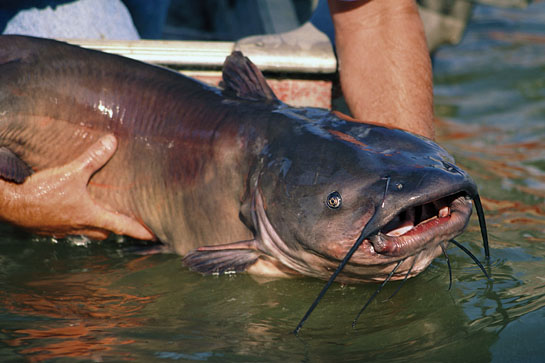
Photo by Keith Sutton
Years ago, I made a journey to world-famous Lake Fork in search of catfish. Our boat full of anglers stuck out like a sore thumb in the slew of glittered bass boats on the Texas lake.
I boated a channel catfish that weighed 21 pounds (long before I understood the importance of the catch-and-release of big fish) and cleaned it that afternoon.
As I was frying the fish at the campground, a game warden walked up and asked about the fish.
Warden: How big was it?
Me: Twenty-one pounds.
Warden: That it you’re cooking?
Me: Yes.
Warden: Hope you enjoy it. You’re eating a lake record—the current record weighs half that.
To this day I’ve not caught a single channel catfish that comes close to that size.
I quickly learned that when referring to channel catfish, the word “big” has vast differences in meaning from state to state or even bodies of water within a state. I learned, too, that pound for pound, channel catfish fight harder than any other catfish species, and even the smallest fish can seem deceptively large when you’re fighting them.
Channel catfish feed on mussels, crustaceans, algae, and dead fish, but they will easily switch to predator mode and feed on live fish. They are sophisticated and have an uncanny ability to find food in a variety of conditions—a far cry from the dumb fish that most consider these bottom dwellers to be.
Bait Selection
No stinkbaits, chicken livers, or secret concoctions here either. Those might be great baits for small fish, but they won’t produce big channel cats consistently. Native fish such as shad, skipjack, or perch are key.
Scale the baitfish and cut them into chunks, experimenting with different sizes. Small baits will catch big fish, but the old saying about using big baits to catch big fish often holds true. And the use of larger baits helps you avoid catching runts. A halved 8-inch shad with the tail cut off is a good starting point in terms of size. You can increase or decrease size from there until you find the sweet spot. Baits of this size may seem too big, but a hungry channel catfish can take it with ease.
Battle Gear
Channels won’t require equipment as heavy as that used for blue and flathead catfish, but lightweight freshwater gear won’t work either.
Balance, sensitivity, and strength are essential. A rod with a light tip with flex and a heavy backbone for pulling larger fish off the bottom or from cover provides the perfect combination.
Longer e-glass or composite rods like the Ugly Stik model CAL110170 flex and bend without breaking and make fish manageable. Combine the rod with an Abu Garcia 5500C3 reel and you have a great rig for larger channel catfish. Monofilament line in 20-pound-test is strong enough to land the biggest of channel catfish, but it’s still light enough for good casting performance.
Rigging
Slip bobbers are often overlooked for channel catfish but perform well in shallow water. The larger fish seem to prefer baits off the bottom, and slip bobbers help that presentation. Slender lightweight bobbers like the Comal Tackle Durafoam slip float don’t create resistance in the water and aid in landing fish. To increase your advantage at night, tape a 2-inch chemical light stick on top of these bobbers. For fishing deeper water, use a standard slip sinker rig with a no-roll sinker and 12-inch leader.
Hybrid circle hooks—part Kahle and part circle hook, but with a wider gap—get the nod for big channels. The 5/0 and 7/0 Daiichi Circle Chunk Light are excellent choices.
Fish Finding
“The hardest part is finding the first one.” An angler buddy mumbled those exact words to me one day as we unsuccessfully moved around searching for fish. It had been one of the worst channel cat fishing days I’d ever experienced. I’d given up mentally and was ready to head for the boat ramp when we decided to hit one last spot.
My buddy’s bait hadn’t hit the water when the slip bobber in front of me vanished and I landed one of the largest channel catfish I’d ever caught.
My partner chuckled and mumbled: “Hardest part, always the hardest part.” What followed was several hours of some of the best action I have experienced for big channel catfish. And that’s how fishing for channel cats typically goes. Finding lone fish happens, but most often if you can simply find one, you’ll soon be busy catching more. They’ll commonly stay in groups of similar size, so if your goal is to catch bigger fish, boating a few 12-inchers is a good sign you’re in the wrong location.
Channels can be found in open water, but they prefer thick cover. If you’re not losing tackle, you’re not far enough into the cover. Aquatic vegetation like cattails or lily pads should never be passed up. Target the edges and then look for open pockets inside of them. They’re havens for insects and sources of food, and fish will stack into these areas by the hundreds. Have patience, take your time, and cover the areas well—inches can make the difference. Sight-fishing might be a foreign concept to many catfish anglers, but watching for channel catfish in the shallows is one of the simplest forms of locating big fish in warmer weather.
Large rocks and riprap shorelines are also great locations to fish. Cats will move in not only to find crayfish and other quick meals, but also to spawn. Fish slow and tight against cover and experiment with depth by adjusting the slip float.
Drift-fishing is an easy tactic to locate and catch big channel catfish and a great technique for inexperienced anglers. Target mid-depth structure and expansive flats that are in shallow or medium depths. Use a trolling motor to move the boat and drag baits along the bottom with a slip-sinker rig or allow your boat to drift with the wind using drift socks to control direction and speed.
Flats Fantastic
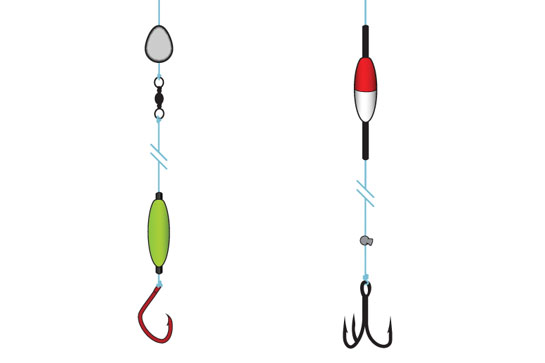
Illustration by Pete Sucheski
A Santee rig (left) consists of a slip sinker, barrel swivel, 18- to 24-inch 40- to 50-pound test leader, 2-inch foam peg float, and 7/0 to 10/0 circle hook. Slip bobber rigs are used when cats prefer bait off the bottom. The rig utilizes a slender bobber, a split shot, and a treble or circle hook.
A call came in from a gentleman trying to book a fishing trip for his dad, who was a terminal cancer patient. At 96 years old, he told his son he was disappointed he’d never caught a big flathead catfish. We made arrangements to get him on the water, but it was a tough time of year and expectations were low.
We sat all night with no activity, and at the eleventh hour the reel started screaming.
Mr. Ward landed his flathead catfish (with assistance from his son), and I didn’t have the slime washed off my hands before another was on the line. He stepped off my boat grinning from ear to ear. He passed away a few weeks later.
I think about Mr. Ward often, but it wasn’t until much later I realized that his two fish combined weighed 96 pounds.
Although they may rank behind blue cats in terms of size and channel cats in terms of popularity, flathead catfish have their legion of devotees, many like Mr. Ward who focus exclusively on trophy fish.
Flatheads are skilled predators with an appetite for live fish. Adults are most often solitary and spend a significant amount of time relatively motionless. They’ll feed heavily at night, often moving shallow to feed and then park. They do feed during the day but often require a modified approach to catch them then.
Targeting flatheads is a rewarding but challenging experience and requires patience. Don’t expect big numbers and fast action. Most flathead anglers consider two fish in a night to be above average. Many nights will see no activity at all.
Bait Selection
Bait preferences may vary, but what is not discretionary is the bait’s condition—hearty and active is mandatory. I’ve always preferred large perch, but I often experiment with various live baits.
Before rigging, trim about half of the tail fin using a sharp pair of scissors, being careful to avoid damaging the meaty parts of the tail. Reducing the fin size causes the fish to struggle and creates more noise in the water. This gives flatheads something to home in on when feeding.
Rigging
A standard slip-sinker rig is simple and effective, and with an 18-inch leader, you can target both shallow and deep fish. Fish with the reel engaged or use a line alarm and allow fish to run with a bait. In deeper water, use a drop-shot rig to reduce snags and hang-ups while fishing vertically.
Fish Finding
The biggest flatheads are found near single pieces of cover and will hold very close to their surroundings. Side-imaging sonar helps locate the isolated cover that flatheads love. Identify these areas by first scanning large sections of water in a slow and deliberate pattern and then zooming in to hunt for fish holding tight to the bottom or against structure.
There’s no better home for flatheads than submerged timber—as simple as a solitary log or a tree lying on a shallow flat with nothing else nearby. I’ve fished one area just like this for years. It’s a vast flat with three large logs in its center. Anchoring carefully allows me to pinpoint casts to the timber. If I do it correctly, I can also cast to an old creekbed and submerged road located on the opposite side of the boat. It’s a flathead trifecta that has rarely failed to produce amazing fish.
Precise bait placement is critical—when you think it’s close enough, get closer and you’ll be just about right. It’s a delicate balance of enticing the fish from their holding area and not getting hung up. Changes of a few inches in bait placement can make all the difference when targeting cover.
The presence of warm weather and rising temperatures brings a significant increase in flathead activity as they prepare for the spawn. Fish that are deep in nests are concealed and heavily protected. Finding these areas is an art form and requires bait in the water. Catch a good flathead just before or during the spawn and you’re on the right track. Catch more than one and you’ve unlocked one of the greatest flathead hotspots available.
